“We knew we didn’t want to do an acoustic version of Teen Spirit, that would’ve been horrendously stupid”: The story of Nirvana's seminal MTV Unplugged set
Resisting network pressure to simply play the hits, Kurt Cobain, Pat Smear, Krist Novoselic, and Dave Grohl pulled together a remarkable and eclectic set that served as the haunting apex of Nirvana's final chapter
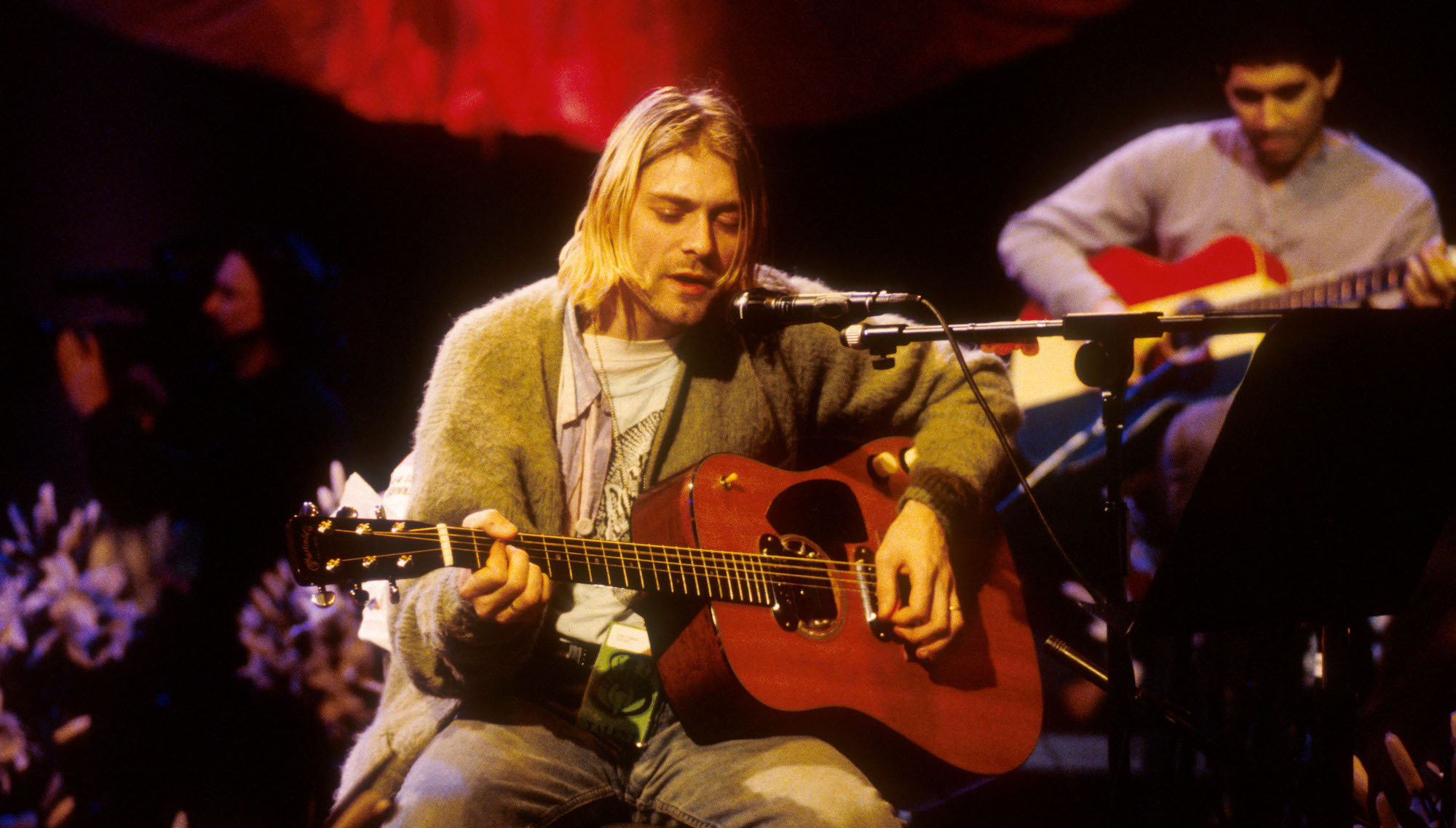
The images have already been burned into some deep, tender part of rock’s collective consciousness: Kurt Cobain, slumped over his Martin acoustic, his tattered librarian sweater and basketball sneakers, the clusters of lilies, the sub-aquatic blue light…
Who can say why MTV chose to air Nirvana’s performance on the network’s Unplugged program over and over, like a tape loop, in the hours and days following the discovery of Cobain’s lifeless body on April 8, 1994?
Many fans might have preferred some bracing footage of Nirvana fully amped up and defiantly live before a seething mosh pit. Instead, there was Nirvana Unplugged, taped just five months before Cobain’s death, and designated as the wake which, through its repeated showings, served to diffuse the rock community’s grief and shock.
The subsequent release of Nirvana’s MTV Unplugged in New York, the CD version of the television concert, was a mournful déjà vu experience for many. It had become impossible to hear this music outside the context of Cobain’s terrible end.
Seen, again and again, in the hours after the artist’s death, the somber MTV gig had an oddly lulling effect. It may have helped some viewers find a calm, quiet way to resign themselves to Cobain’s violent departure. But the effect was pretty spooky, too. It was as if the guy was singing at his own funeral. Or singing to us from some tranquil, blue world beyond our own.
An eerie coincidence? Probably. But of the six cover songs Cobain chose to sing that evening, five mention death in some way. And the lilies, candles, and heavy drapery that adorned the Unplugged set that night were all chosen by Cobain. In fact, when Unplugged producer Alex Coletti showed the Nirvana leader some preliminary sketches for the stage set, Kurt called for more flowers, more candles.
“You mean like a funeral?” Coletti asked.
Get The Pick Newsletter
All the latest guitar news, interviews, lessons, reviews, deals and more, direct to your inbox!
“Yeah,” replied Cobain.
“I don’t want to read too much into it,” says Coletti in retrospect, “but that memory sure spooked me out a couple of months later.”
Apart from any of the show’s real or imaginary morbid overtones, for Cobain, the opportunity to do MTV Unplugged may well have meant the confirmation of his arrival as an important rock songwriter.
“I’m embarrassed saying this, but I’d like to be recognized more as a songwriter,” Cobain told Details magazine in November of ’93. “I don’t pay attention to polls and charts, but I thumb through them once in a while and see, like, Eddie Vedder is nominated number-one songwriter in some magazine, and I’m not even listed.”
Beginning with its debut broadcast in January 1990, MTV Unplugged was always a songwriters’ forum. The show gave tunesmiths an opportunity to strip away the high decibels and big production values and let their compositions stand on their own melodic and lyrical integrity.
In 1993, Nirvana had begun working some acoustic numbers into their live set, “just to wind things down,” Nirvana bassist Krist Novoselic told MTV News. “But people still manage to writhe around and throw shoes and land headfirst over the barrier and crack their heads open.”
Unplugged gave Nirvana a chance to test their acoustic mettle under slightly more favorable conditions.
“I was surprised but delighted when they said yes to doing the show,” says Coletti. Coletti had worked with Nirvana once before. On January 10, 1992, when Nirvana were in New York City to do Saturday Night Live, he had videotaped a live set with the band. “Various clips from that have been aired on MTV,” Coletti notes, “but never the whole thing.”
The January ’92 taping was an impromptu session, knocked together at the last minute, but it gave Coletti some useful insights into the band.
“That one experience of working with Kurt showed me how sensitive he was as a person. Some bands will just walk in and it’s like, ‘Whatever. Point and shoot. Let’s do it and get out of here.’ But Kurt seemed to like to take things and internalize them.
Kurt wanted something that would break away from just the normal, dull TV set
Alex MacLeod, Nirvana tour manager
“I’d heard that he was something of a visual artist. So, beyond making sure he was happy with the stage set, since he seemed to show some interest in it, I thought it would be good if he had some creative input into it.”
Early in the planning stages of their Unplugged appearance, Nirvana tour managers Alex MacLeod and Jeff Mason acted as intermediaries between Cobain and Coletti, passing the guitarist’s ideas and wishes on to the producer.
“Kurt wanted something that would break away from just the normal, dull TV set,” says MacLeod. “He didn’t want it to look like just a bare stage. He had seen a lot of Unplugged shows before, and felt they weren’t really unplugged. His feeling was that a lot of the bands would just use semi-acoustic instruments and play their songs exactly the same way they would if they were doing a full show.
“He wanted to make Nirvana’s Unplugged appearance slightly different, sort of a downbeat kind of set. Really laid back. To just go in and play a bunch of songs and make changes to the arrangements to some extent. They tried to stick to acoustic instruments as much as possible. Kurt wanted to make it something that would show a whole different side of the band.”
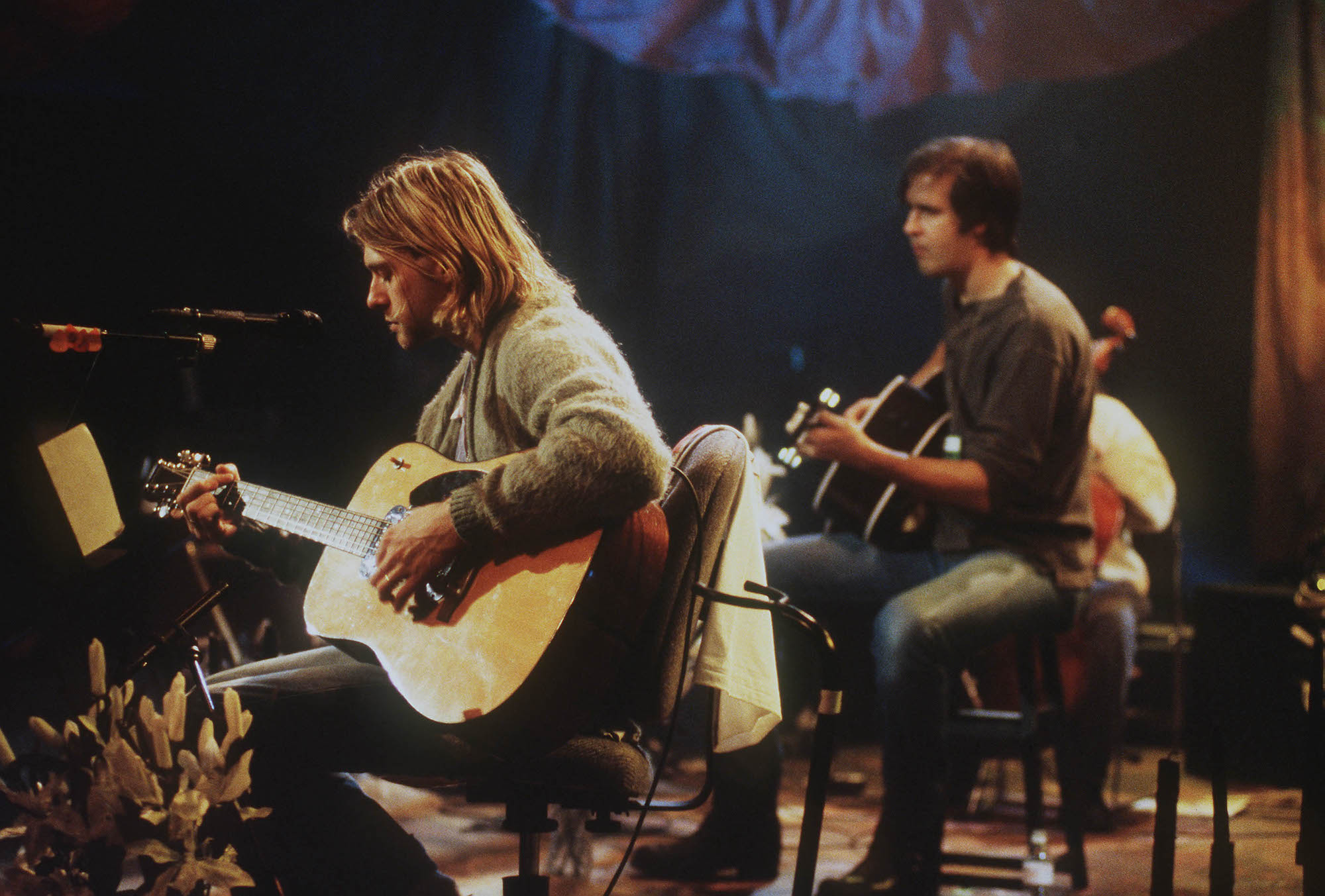
After exchanging these preliminary ideas through MacLeod and Mason, Coletti felt the time was ripe for a face-to-face meeting with Cobain.
In November of ’93, a few weeks before the taping, Coletti flew up to a Nirvana gig in a remote part of New England, somewhere north of Boston. He was armed with rough sketches of the stage set which embodied Cobain’s ideas, and with his own personal Ovation semi-acoustic bass guitar. The latter was meant to be loaned to Krist Novoselic in the event that the Nirvana bassist didn’t have an “unplugged bass” of his own.
“It was not a glamorous backstage by any means,” Coletti recalls. “The show was in a high school hockey arena. After the show, the band went back to this room and had a catered meal. It was nothing fancy, just franks and beans and a bottle of wine.
“There were a good dozen people in the room: the band and some friends. So I just got thrown in this room and sat down next to Kurt. No one even bothered to introduce us or anything; it was sort of an awkward situation. So I said, ‘Is this a bad time? Do you want to do this now or what?’ But he immediately became very friendly, like, ‘Oh, oh, the MTV thing. No, let’s do it now.’
“I was prepared to give him the whole Unplugged spiel, which is to talk about set lists, sound equipment, and things. But it just seemed like it wasn’t the right time. So I simply said, ‘Hey look, I’ve got some set drawings.’”
Like many people who worked with Cobain in a professional capacity, Coletti describes the late guitarist as a courteous collaborator, respectful of other people’s expertise and quietly hopeful of being respected in turn. “He gave us flexibility. He was pretty cooperative,” says Coletti. “He did specify that he wanted star lilies, which are these big, white flowers.”
It was at this meeting that the ominous “funeral” remark went down. But before anyone could dwell on it, Krist Novoselic burst into the room brandishing the Ovation bass Coletti had left for him.
We knew we didn’t want to do an acoustic version of Teen Spirit, that would’ve been horrendously stupid
Dave Grohl
“He was like, ‘Look what I got!’ Like a big kid,” Coletti narrates. “Kurt just looks up and says, ‘That’s the ugliest fucking thing I’ve ever seen in my life.’ Krist is like, ‘Oh, man, I wanna use it on the show.’ Kurt said, ‘Well, maybe if we fuck it up and bash it up and put some stickers on it…’ And I went, ‘Umm, you can’t do that, Kurt. That’s mine!’ He got really apologetic, like, ‘I’m sorry. I didn’t really mean the ugly crack.’”
The set list was another point of discussion, if not contention, between Nirvana and MTV. There were two potential sore points between the parties. First, the band wanted to fill nearly half of their set with obscure covers.
“Right away,” recalls Alex MacLeod, “we started sorting out how many covers there would be time for, how many songs MTV wanted them to do in total. Just general things like that.”
Also disturbing for MTV was the fact that – with the exception of Come As You Are – the band wasn’t planning to perform any big, instantly recognizable Nirvana hits.
“We knew we didn’t want to do an acoustic version of Teen Spirit,” drummer Dave Grohl later commented. “That would’ve been horrendously stupid. We felt it would be better if we found other songs.”
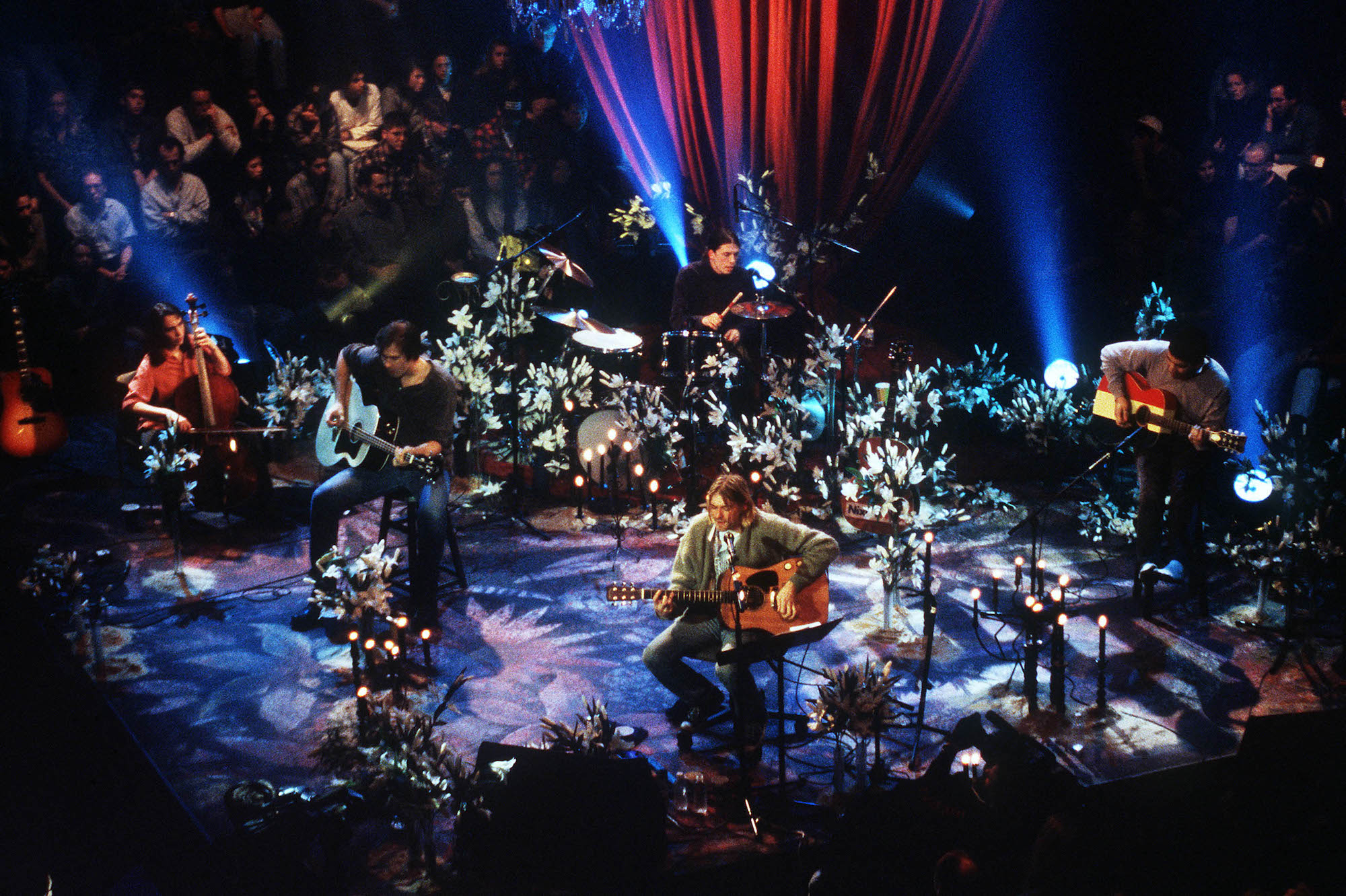
According to MacLeod, there was also a practical side to the band’s decision not to perform many hits: “They were like, ‘We’d love to do that, but a lot of those songs are really dull if we were to do them that way. They didn’t really work acoustically.’ The band just thought that there were other songs better-suited to the acoustic format.”
The decision to do so many covers reflects a selfless (perhaps insecure) desire on Cobain’s part to share the spotlight with other songwriters.
He was a tireless proselytizer for bands he really loved, like the Vaselines, Scottish buzz-pop supremos led by Eugene Kelly, who now fronts the band Eugenius. Nirvana had covered Vaselines tunes in the past, including Molly’s Lips and Son of a Gun. (These early recordings were later collected on the Incesticide CD).
The Meat Puppets were another of Kurt’s obsessions.
“He told me the second Meat Puppets album was great,” Cobain’s widow, Courtney Love, recalled in a December ’94 interview with Rolling Stone. “I couldn’t stand [the album]. Then he played [those songs] to me – his voice, his cadence, and his timing. And I realized he was right. I got to sit and listen to this, man.”
Thanks to Unplugged, Cobain’s fans got a chance to replicate Love’s experience. Kurt’s performance of the Puppets’ Plateau, Oh Me, and Lake of Fire have a ragged vulnerability that’s far more personal and affecting than any calculated run-through of Teen Spirit could have been.
In retrospect, there was solid wisdom in Coletti’s decision to weather his MTV superiors’ pressure to see Nirvana play its hits and honor Cobain’s intentions instead.
“Kurt said he really enjoyed those Meat Puppets songs because he really had to push his voice,” Coletti observes. “Like he didn’t feel good singing them. He picked them purposely because they were challenging vocally for him.”
Many of the decisions about songs and arrangements went down at two, day-long rehearsals held prior to the day of taping.
“They were at the SST rehearsal facility in New Jersey,” Alex MacLeod recalls. “We brought our own monitor system in. Also, because we were on tour at the time, they were working on stuff during soundcheck. Kurt worked on his own, too.”
Since the Meat Puppets were on tour with Nirvana at the time, and Cobain was planning to sing three of their tunes, it seemed a natural move to invite the two principal Puppets, siblings Curt and Cris Kirkwood, to come lend a hand on acoustic guitars. “Why not?” Novoselic later quipped. “We weren’t learning their songs right anyway.”
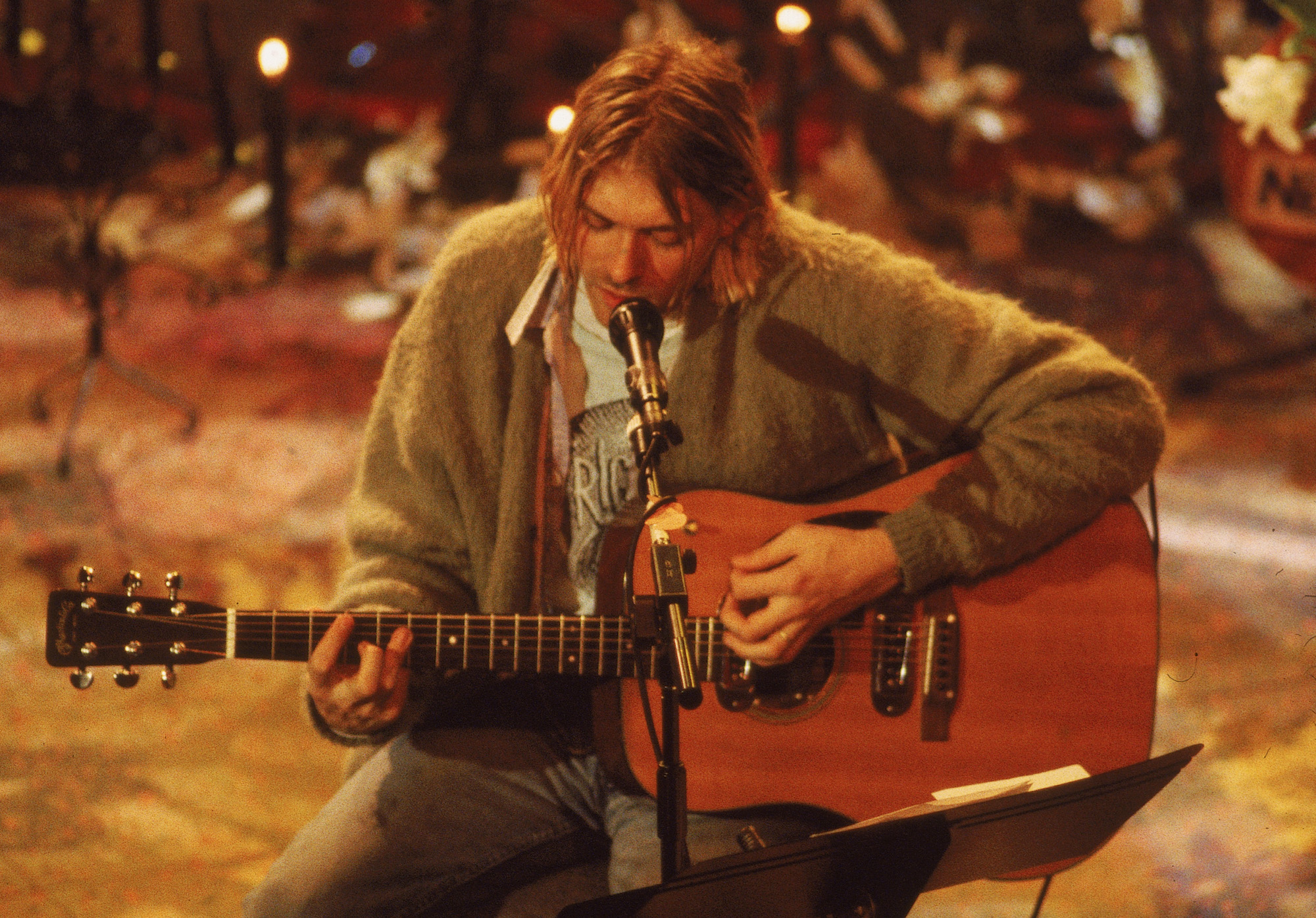
Back at MTV HQ, the decision to include the Meat Puppets in the broadcast was hardly greeted with jubilation.
Alex Coletti recalls: “I said to MTV, ‘They’re going to bring some guests on.’ And at first everybody’s eyes lit up, like, ‘Who’s it gonna be?’ They wanted to hear the ‘right’ names’ – Eddie Vedder or Tori Amos or God knows who. But when I said, ‘the Meat Puppets,’ it was kind of like, ‘Oh great. They’re not doing any hits, and they’re inviting guests who don’t have any hits to come play. Perfect.’”
Nirvana seemed intent on bringing sonic variety to their set. Along with the Kirkwood brothers, they also included cellist Lori Goldston and former Germs guitarist Pat Smear, both of whom had been playing with Nirvana on their tour.
Covering the Vaselines’ Jesus Doesn’t Want Me for a Sunbeam gave Krist Novoselic a chance to put down his bass and strap on an accordion.
The accordion, he told MTV News, “was the first instrument I learned when I was young. And Kurt bought one, this really neat red one. And I go, ‘Hey, check this out.’ And I put it on and started playing it. And then we were starting to screw around with rehearsals for Unplugged and we did Jesus Doesn’t Want Me for a Sunbeam. There’s this violin or organ [on the original recording] and I go, ‘I know. I’ll play the accordion on in this song!’ I picked it up and started playing, and it sounded really cool.”

Despite the band’s preparations, Alex MacLeod describes their overall mood as “nervous” as the day of the show approached: “It was the first time in a long while I’d seen them all so nervous about doing something. Things had gotten to the point where they’d go out playing in front of 7,500 or 10,000 people and it was just like [very nonchalantly], ‘Okay, boom, let’s do it.’ But they were really nervous about doing Unplugged. Because they were really leaving themselves wide open.”
As Alex Coletti remembers it, Grohl and Novoselic were the first to turn up at Sony Music Studios, at 54th Street and 10th Avenue in Manhattan, on November 18, 1993.
Kurt was neither a collector nor a connoisseur of rare guitars. I think he saw the D-18E as an oddity, hoping it would sound as good as it looked
Earnie Bailey, Nirvana guitar tech
It was around 3:00 in the afternoon, the appointed time for Unplugged’s pre-show camera rehearsal/soundcheck.
Concerned with Grohl’s propensity to hit the drums really hard, Coletti presented him with some brushes and sizzle sticks, a type of stick used in classical percussion, consisting of several slender dowels loosely wrapped and providing a softer impact than a solid drumstick. Since it was around the holiday season, Coletti had the sticks wrapped up in Christmas paper.
“I figured I’d be remembered forever as the dick MTV producer,” Coletti laughs. “I was afraid Dave would just roll his eyes, like, ‘Oh great, the asshole from MTV is trying to be my friend.’ But instead he opened the package and said, ‘Cool, I’ve never had brushes before. I’ve never even tried using them.’ As it turned out, he used both the sticks and the brushes. It’s nice that the band was so amenable to trying new things.”
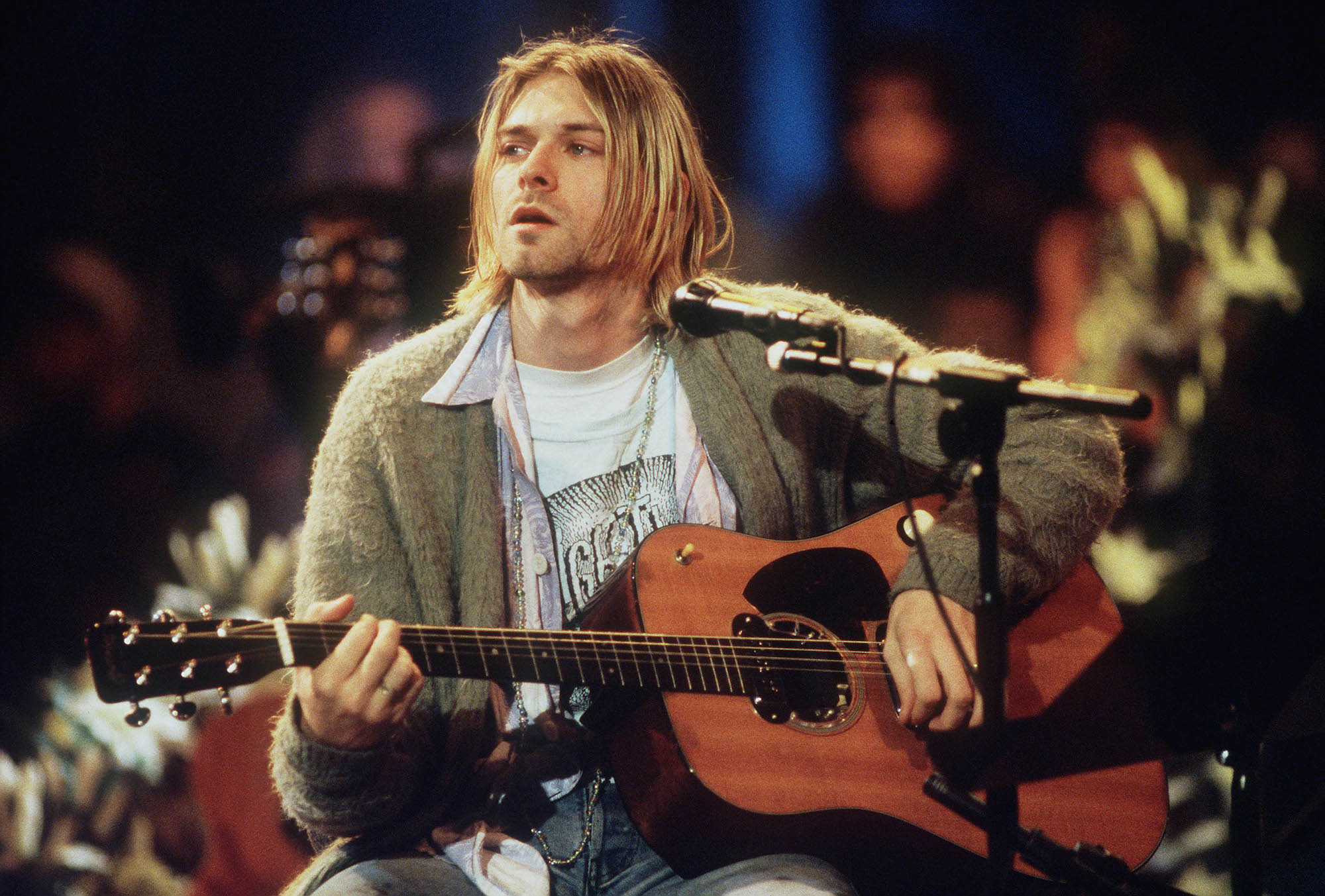
In the end, Novoselic didn’t use Coletti’s Ovation bass but rather a Guild semi-acoustic bass guitar rented from S.I.R. in New York – an instrument that has been used on other episodes of Unplugged.
Pat Smear played an inexpensive, red, white, and-blue Buck Owens model guitar that belongs to Novoselic, and had been extensively reworked by Nirvana guitar technician Earnie Bailey “to get it to sound like a guitar and not a kid’s toy,” as Alex MacLeod puts it.
Up in the sound booth sat noted record producer Scott Litt (R.E.M., John Mellencamp), who had remixed two tracks from In Utero and worked with Nirvana on MTV’s Live and Loud New Year’s Eve show. (Litt went on to produce the Nirvana Unplugged in New York CD.) The band and cellist Lori Goldston were already onstage when Cobain arrived, notably unaccompanied by Love.
“I think that was planned,” says Alex Coletti. “I think he was a little too nervous to have Courtney and the baby there.”
For the show, Cobain played a Martin D-18E that he had purchased at Voltage Guitar in Los Angeles during the fall of ’93, and which had become his main acoustic. With his characteristic flair for the oddball, the guitarist had picked up a rare misfit.
The D-18E, one of Martin’s earliest stabs at an electrified guitar, is essentially a D-18 acoustic with two pickups, three control knobs, and a selector switch grafted on.
Introduced in 1958, it was discontinued in 1959; only 302 were ever produced. The instrument was the perfect acoustic (sort of) counterpart to the trashed old Mustangs and Jaguars favored by Cobain, not to mention the thrift shop clothes and doll parts he accumulated. But unlike his beautifully threadbare cardigans, this Cobain cast-off had some real intrinsic value.
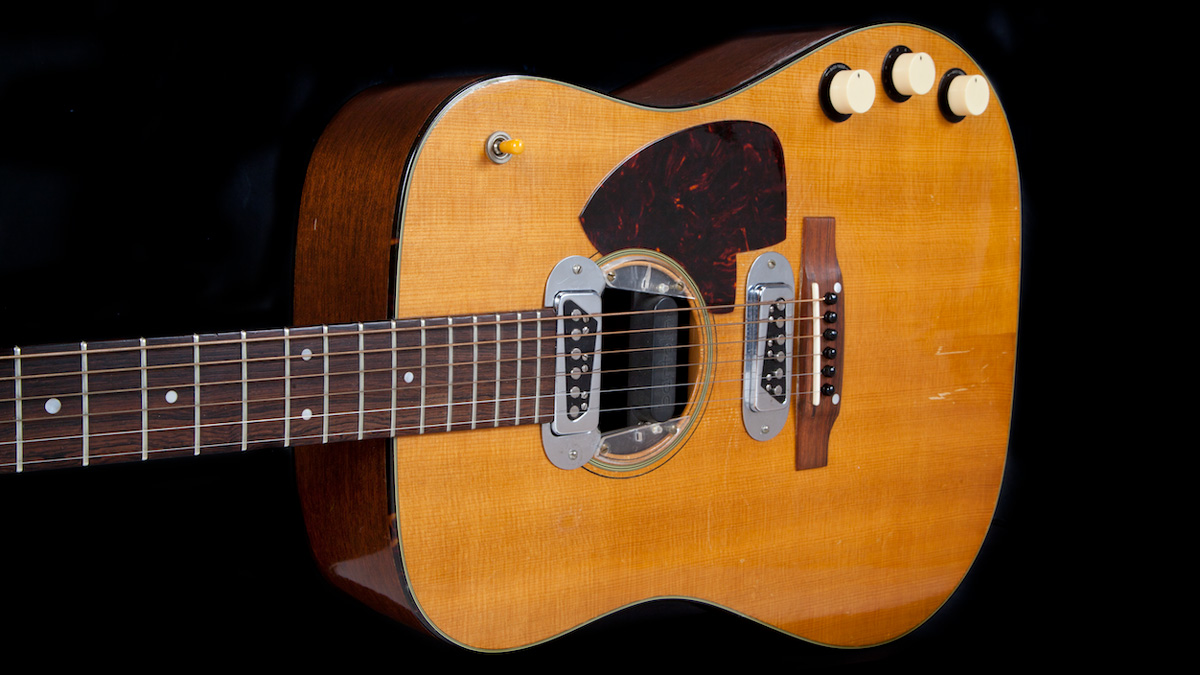
“I don’t believe he had any idea how rare it was before he bought it,” says Earnie Bailey. “Kurt was neither a collector nor a connoisseur of rare guitars. I think he saw [the D-18E] as an oddity, hoping it would sound as good as it looked.
“Unfortunately, the instrument’s DeArmond pickups were designed with nickel strings in mind, so hearing it with bronze-wound strings was pretty disappointing. Our solution was to attach yet another pickup – a Bartolini model 3AV – to the top of the Martin. Kurt first became interested in [the Bartolini pickup] when he saw Peter Buck using one and really liked the sound.”
[Ed. In 2020, Cobain's MTV Unplugged D-18E would sell at auction for $6 million, making it the most expensive guitar ever sold at auction, a record it holds to this day.]
While the usual procedure is for acoustic guitars to run direct, Cobain insisted on putting his Martin through his trusty Fender Twin Reverb amp and his usual array of effects boxes.
“Maybe I shouldn’t give this secret away,” Alex Coletti laughs, “but I built a fake box out in front of the amp to make it look like a monitor wedge. It was Kurt’s security blanket. He was used to hearing this guitar through his Fender. He wanted those effects. You can hear it on The Man Who Sold the World [the David Bowie song covered by Nirvana on Unplugged].
“It’s an acoustic guitar, but obviously he’s going through an amp. There’s no trying to pull the wool over anybody’s eyes. I actually fought pretty hard to leave that song out. Because I felt it wasn’t as genuine as the rest of the songs. But I’m a huge Bowie fan, so I couldn’t fight too hard against the song.”
As a concession to the Unplugged aesthetic, Earnie Bailey did modify the amp for the show.
“To keep the Twin as clean as possible, I switched the 7025 power tubes to 12AX7s and substituted the 12AT7 phase inverter to a 12AU7. By the time Kurt showed up, everything was pretty much dialed in, right down to listening to the pickup balance from the control room.”
It is standard Unplugged procedure to videotape the camera rehearsal/soundcheck for each show.
Nirvana’s Unplugged rehearsal tape is packed with revelations. More than anything else, Cobain looks tired. His face reflects that unmistakable road weariness that takes hold of musicians after months and months of dealing with strange places, strange situations, and even stranger people.
Throughout the rehearsal, Cobain’s mood varies from low-keyed bitchiness over technical foul-ups to a kind of deadpan, humorous take on the whole proceeding. He calls the second number of the rehearsal, About a Girl, to an abrupt halt, demanding, “How many more times is that fuckin’ feedback gonna happen when I turn my head to the left?”
Later on, he calls for Finger-Eze to help him smooth out the song’s solo: “You know that goofy-ass stuff? It’s like anal gel.” He later explains that he’d never used the fretboard lubricant before, but that his “country and western aunt” used to do so. He nevertheless knows enough to specify that he wants the roll-on rather than the spray. “God, I’m being picky today,” he says with mock self-derision.
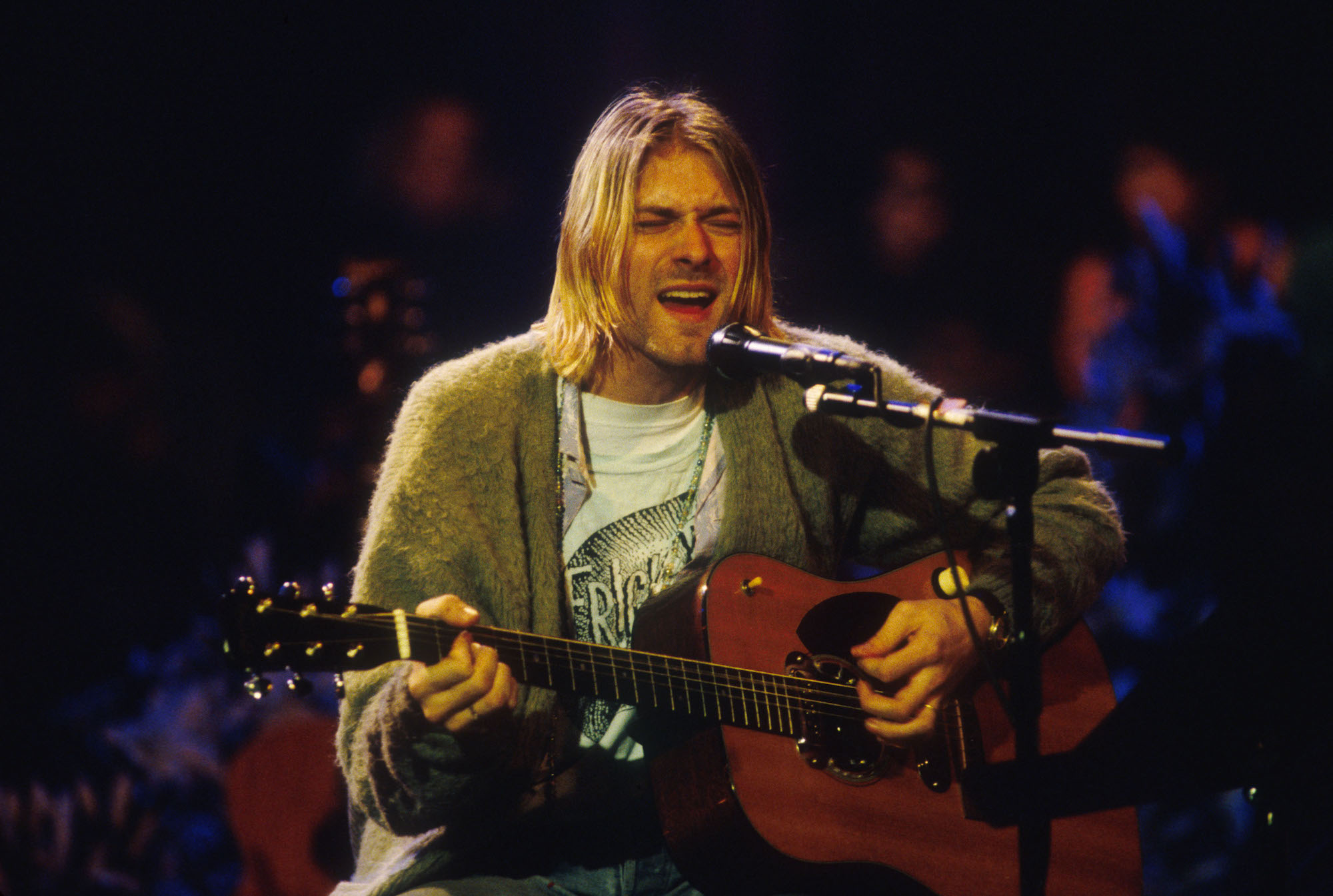
The whole band seem mildly amused at receiving the superstar treatment from MTV.
“Uh, my candle went out. Can somebody please light it?” Dave Grohl demands at one point with stagey hyper-professionalism. “This fucking sand is ridiculous,” Cobain says of the substance in which the candelabra and vases were anchored.
What also comes across unmistakably on the videotape is the extent to which Cobain was in charge of Nirvana. He tells Dave Grohl when he’s singing flat and directs him to play louder at several junctures. He directs Pat Smear to not keep changing his amp volume. And although he is known for the punkish nonchalance of his guitar approach, the rehearsal tape shows that Cobain could be quite obsessive about tone and guitar equipment.
They were still like, ‘Oh my God, we haven’t rehearsed enough. Oh shit, we’re gonna blow this totally’
Alex MacLeod
He enters into a lengthy debate with one technician over the various qualities of his two Electro-Harmonix Echo Flangers. Later he asks about the feasibility of acquiring replacement machine heads for his Martin. “These aren’t good machine heads,” he sadly observes.
As the rehearsal progresses, the trouble spots in the set soon become obvious. One is the aforementioned Man Who Sold the World. Cobain can’t seem to get past the first chorus without blowing the chord changes. “Sorry,” he tells the others. They try the song again and again but never manage to get all the way through it. In the end they decide to move on.
“What should we do next, Scott?” shouts Cobain into the darkness above his head. Of all the people on the set, Litt is the only one to whom he seems to defer. The band move on to a flawless performance of Polly and get halfway through Dumb before a monitor snafu again brings things to a halt.
“MTV Poltergeist,” Cobain quips. Trouble rears its ugly head once more when they move on to Pennyroyal Tea. Pat Smear persists in resolving his chorus harmony vocal to a flagrantly wrong note. Again, the band attempt the song repeatedly, with no success.
They try it with Grohl playing Smear’s guitar so he can concentrate on his harmony. That doesn’t work either. The situation grows painfully reminiscent of the infamous “Well, fuck me, Reg” Troggs rehearsal tape, bootleg copies of which used to circulate among musicians. Once more, the band decide to move on without resolving the problem.
Jesus Doesn’t Want Me for a Sunbeam comes off infinitely better. But Cobain still seems uneasy. He calls out for someone named Amy (perhaps the Amy Finnerty mentioned in the Unplugged CD liner notes): “Amy, can you sit in the front when we play?” Cobain asks. “You and Janet and everyone I know? [Presumably Janet Billig, from Nirvana’s management company.] ’Cause I hate strangers.”
The onstage arrival of “The Brothers Meat” lightens the mood considerably. Their three numbers go well, and the rehearsal closes with a confident reading of All Apologies. Nirvana leave the stage having assayed 11 of the 14 songs in their set.

According to Alex MacLeod, the postsoundcheck vibe was fairly tense.
“They were still like, ‘Oh my God, we haven’t rehearsed enough. Oh shit, we’re gonna blow this totally.’” After leaving the stage, the band retired to a room upstairs at the Sony facility for a two-hour dinner break. Over the meal, the delicate question of the set list again presented itself.
Alex Coletti narrates: “There was this whole subtext of ‘try to get Kurt to do more hit songs’ that prevailed throughout the day among myself, my boss, and management.
“The other thing was we were really pressuring Scott Litt, like, ‘Hey, see if you can get more songs out of them, or better songs.’ Again, I’m not saying it was the right thing to do. I think what we got was great. Kurt just chose to take a different road with it. I guess it wasn’t the road we were all in sync on. Not that he went in a bad direction at all.”
At 8:30 that evening, the audience was “loaded in,” as they say at MTV. As it turned out, many of the front row seats were given to New York–area Nirvana fan club members – probably not familiar faces to Cobain, but far from hostile ones.
Taping began at nine. Somehow, magically, the rough spots from soundcheck simply seemed to vanish.
“I guarantee you I will screw this song up,” Cobain nervously announces before starting The Man Who Sold the World. But he doesn’t. The Pennyroyal Tea problem resolves itself nicely, too.
“Am I doing this by myself or what?” Cobain demands. “Do it yourself,” Dave Grohl calls out, deftly seizing the opportunity. This impromptu arrangement decision contributed greatly to the show’s informal, intimate vibe. Cobain turns in a memorable performance of a song that was always one of his most affecting statements about his own ailment and discontent.
From here on in, Cobain seems to grow more relaxed and confident.
One of the themes of jokes during soundcheck – MTV’s “superstar treatment” – winds up working well during the show too.
“Aren’t we, like, a rich rock band?” Cobain cracks as everyone waits for one of the Meat Puppets’ guitars to be brought out. “Shouldn’t we have a million guitars?”
Despite the informal, jokey vibe, Coletti recalls that the Nirvana Unplugged shoot was remarkably tight and hassle free. “With most Unpluggeds, we tended to run through the set, have a chat, and then do a few songs over again. But this was truly one take – every song, straight through, in one hour.”
Cobain pulled out all the stops on the final song – a riveting version of Where Did You Sleep Last Night, a traditional tune recorded by another of his musical heroes, the American folksinging archetype, Leadbelly. Having done pained, screaming justice to the death-haunted ballad, Cobain left the stage, never to return.
“I really tried to get him to do an encore,” Alex Coletti remembers. “I had Dave, Krist, and Pat ready to do it. But Kurt just wasn’t into it. I was just doing my job for MTV at that point, trying to get that one extra song in the can, to see if the night could produce one more gem. The pleading went on for about five minutes. Finally Kurt said, ‘I can’t top that last song.’ And when he said that, I backed off. ’Cause I knew he was right.”
This article was originally printed in the March 1995 issue of Guitar World.
In a career that spans five decades, Alan di Perna has written for pretty much every magazine in the world with the word “guitar” in its title, as well as other prestigious outlets such as Rolling Stone, Billboard, Creem, Player, Classic Rock, Musician, Future Music, Keyboard, grammy.com and reverb.com. He is author of Guitar Masters: Intimate Portraits, Green Day: The Ultimate Unauthorized History and co-author of Play It Loud: An Epic History of the Sound Style and Revolution of the Electric Guitar. The latter became the inspiration for the Metropolitan Museum of Art/Rock and Roll Hall of Fame exhibition “Play It Loud: Instruments of Rock and Roll.” As a professional guitarist/keyboardist/multi-instrumentalist, Alan has worked with recording artists Brianna Lea Pruett, Fawn Wood, Brenda McMorrow, Sat Kartar and Shox Lumania.
“The main acoustic is a $100 Fender – the strings were super-old and dusty. We hate new strings!” Meet Great Grandpa, the unpredictable indie rockers making epic anthems with cheap acoustics – and recording guitars like a Queens of the Stone Age drummer
“You can almost hear the music in your head when looking at these photos”: How legendary photographer Jim Marshall captured the essence of the Grateful Dead and documented the rise of the ultimate jam band








![A black-and-white action shot of Sergeant Thunderhoof perform live: [from left] Mark Sayer, Dan Flitcroft, Jim Camp and Josh Gallop](https://cdn.mos.cms.futurecdn.net/am3UhJbsxAE239XRRZ8zC8.jpg)








